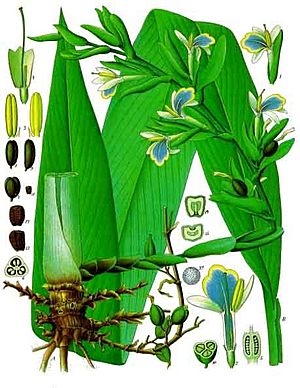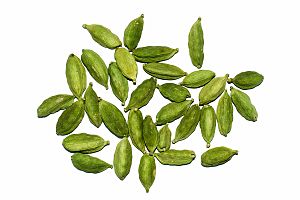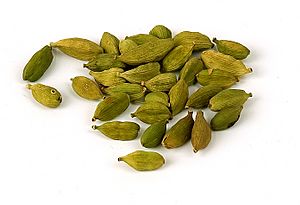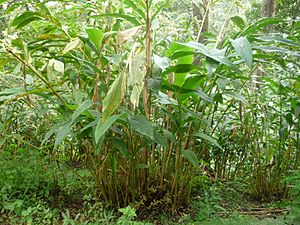Green cardamom facts for kids
Quick facts for kids Green cardamomTrue cardamom |
|
|---|---|
 |
|
| True cardamom (Elettaria cardamomum) 1896 illustration |
|
 |
|
| Scientific classification | |
| Genus: |
Elettaria
|
| Species: |
cardamomum
|
Elettaria cardamomum, also known as green or true cardamom, is a plant from the ginger family. It grows in southern India and is a perennial plant, meaning it lives for more than two years. Its seeds are used as a popular spice called cardamom. This plant is grown in many tropical areas around the world. You can find it growing naturally in places like Réunion, Indochina, and Costa Rica.
How Green Cardamom Grows
Green cardamom is a plant with a strong, pleasant smell. It can grow quite tall, reaching about 2 to 4 meters (6.5 to 13 feet) high. Its leaves are long and narrow, about 40 to 60 centimeters (15 to 23 inches) in length.
The plant produces flowers that can be white, lilac, or light violet. These flowers grow in a loose spike that is about 30 to 60 centimeters (11 to 23 inches) long. After the flowers, the plant grows a fruit. This fruit is a yellow-green pod with three sides, about 1 to 2 centimeters (0.4 to 0.8 inches) long. Inside each pod, there are about 15 to 20 small black and brown seeds.
What is Green Cardamom Used For?
The green seed pods of the cardamom plant are picked and dried. The seeds inside these pods are then used as a spice. People use them whole or ground into a powder. Green cardamom is very popular in Indian and other Asian cuisines. It is the most common type of cardamom used around the world.
Long ago, people in Ayurveda (an ancient Indian medicine system) might have used true cardamom as early as the 4th century BC. Today, ground cardamom is a key ingredient in many Indian curries. It also gives masala chai (a spiced tea) its special flavor. In countries like Iran and India, cardamom is often used to flavor coffee and tea.
Besides its original home, green cardamom is now grown in many other countries. These include Nepal, Vietnam, Cambodia, Thailand, Sri Lanka, and parts of Central America. In India, the states of Sikkim and Kerala are the biggest producers of cardamom. They have the most land used for growing it and produce the most spice.
Types of Green Cardamom
There are three main natural types of green cardamom plants:
- Malabar: This type is native to Kerala, a state in India. Its flower stems, which hold the pods, grow sideways along the ground.
- Mysore: This type comes from Karnataka, another Indian state. Unlike Malabar, its flower stems grow straight up. The Mysore type is not as common now because a stronger, better-yielding type called 'Green Gold' has become more popular, especially in Kerala.
- Vazhuka: This is a natural mix of the Malabar and Mysore types. Its flower stems grow somewhere in between, neither fully vertical nor fully horizontal.
Farmers have also found special plants that produce a lot of cardamom. They have grown more of these high-yielding plants. One very popular type is 'Njallani'. An Indian farmer named Sebastian Joseph developed this unique type in Kerala. Another farmer, K. J. Baby, also from Kerala, found a type of Vazhuka cardamom with white flowers. This type gives even more pods than 'Njallani' and can grow well in different light conditions, even in wet areas.
Images for kids
See also
 In Spanish: Cardamomo verde para niños
In Spanish: Cardamomo verde para niños






